Causes, impacts and patterns of disastrous river floods
Disastrous floods have caused millions of fatalities in the twentieth century, tens of billions of dollars of direct economic loss each year and serious disruption to global trade. In this Review, we provide a synthesis of the atmospheric, land surface and socio-economic processes that produce river floods with disastrous consequences. Disastrous floods have often been caused by processes fundamentally different from those of non-disastrous floods, such as unusual but recurring atmospheric circulation patterns or failures of flood defences, which lead to high levels of damage because they are unexpected both by citizens and by flood managers. Past trends in economic flood impacts show widespread increases, mostly driven by economic and population growth. However, the number of fatalities and people affected has decreased since the mid-1990s because of risk reduction measures, such as improved risk awareness and structural flood defences. Disastrous flooding is projected to increase in many regions, particularly in Asia and Africa, owing to climate and socio-economic changes, although substantial uncertainties remain. Assessing the risk of disastrous river floods requires a deeper understanding of their distinct causes. Transdisciplinary research is needed to understand the potential for surprise in flood risk systems better and to operationalize risk management concepts that account for limited knowledge and unexpected developments.
Key points
- The causative mechanisms of floods with disastrous consequences tend to be different from those of non-disastrous floods, and show anomalies in one or several flood- and loss-generating processes.
- Past trends in flood hazard show both upward and downward changes. In some regions, anthropogenic warming is already strong enough to override other drivers of change.
- Flood hazards and impacts are projected to increase for many regions around the globe. Future flooding hotspots are expected in Asia and Africa, owing to climate and socio-economic changes.
- Reducing vulnerability is a particularly effective way of reducing flood impacts. Global decreases in flood-affected people and fatalities since the mid-1990s (despite a growing population) are signs of effective risk reduction.
- Disastrous floods often come as a surprise. Effective risk reduction requires an understanding of the causative processes that make these events distinct and to address the sources of surprise, including cognitive biases.
This is a preview of subscription content, access via your institution
Access options
Access Nature and 54 other Nature Portfolio journals
Get Nature+, our best-value online-access subscription
cancel any time
Subscribe to this journal
Receive 12 digital issues and online access to articles
133,45 € per year
only 11,12 € per issue
Buy this article
- Purchase on SpringerLink
- Instant access to full article PDF
Prices may be subject to local taxes which are calculated during checkout

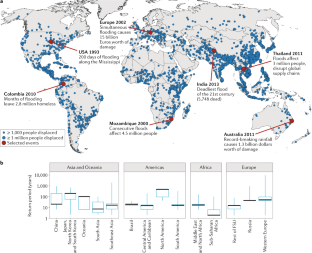
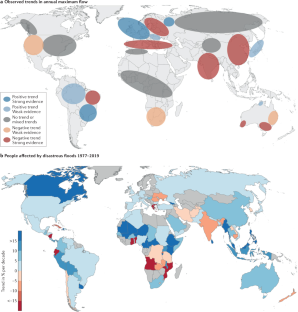
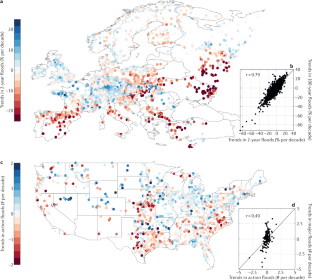
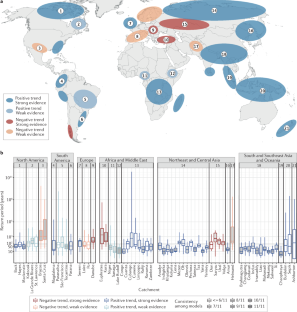
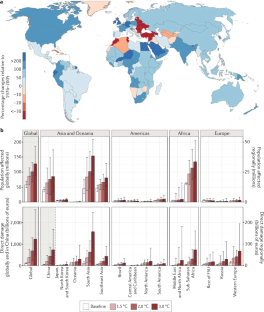
Similar content being viewed by others
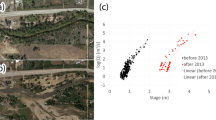
Floods and rivers: a circular causality perspective
Article Open access 20 March 2020
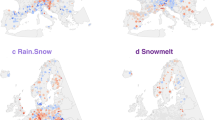
Shifts in flood generation processes exacerbate regional flood anomalies in Europe
Article Open access 23 February 2023
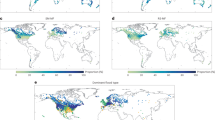
Reconciling disagreement on global river flood changes in a warming climate
Article 28 November 2022
Data availability
The authors declare that the data supporting the findings of this study are available within the article and its supplementary information files. Other data can be provided by the authors on request.
References
- Doocy, S., Daniels, A., Murray, S. & Kirsch, T. D. The human impact of floods: a historical review of events 1980−2009 and systematic review. PLOS Curr. https://doi.org/10.1371/currents.dis.f4deb457904936b07c09daa98ee8171a (2013).
- United Nations Office for Disaster Risk Reduction GAR2015 — Global Assessment Report on Disaster Risk Reduction. (UNDRR, 2015).
- Jongman, B., Ward, P. J. & Aerts, J. C. J. H. Global exposure to river and coastal flooding: long term trends and changes. Glob. Environ. Change22, 823–835 (2012). ArticleGoogle Scholar
- Dottori, F. et al. Increased human and economic losses from river flooding with anthropogenic warming. Nat. Clim. Change8, 781–786 (2018). ArticleGoogle Scholar
- Barendrecht, M. H., Viglione, A. & Blöschl, G. A dynamic framework for flood risk. Water Secur.1, 3–11 (2017). ArticleGoogle Scholar
- Vorogushyn, S. et al. Evolutionary leap in large-scale flood risk assessment needed. Wiley Interdisc. Rev. Water5, e1266 (2018). ArticleGoogle Scholar
- Di Baldassarre, G. et al. Debates — perspectives on socio-hydrology: capturing feedbacks between physical and social processes. Water Resour. Res.51, 4770–4781 (2015). ArticleGoogle Scholar
- Merz, B. et al. Floods and climate: emerging perspectives for flood risk assessment and management. Natural Haz. Earth Syst. Sci.14, 1921–1942 (2014). ArticleGoogle Scholar
- Merz, B., Hall, J., Disse, M. & Schumann, A. Fluvial flood risk management in a changing world. Natural Haz. Earth Syst. Sci.10, 509–527 (2010a). ArticleGoogle Scholar
- Chen, Y. et al. Socio-economic impacts on flooding: a 4000-year history of the Yellow River, China. Ambio41, 682–698 (2012). ArticleGoogle Scholar
- Munoz, S. E. et al. Climatic control of Mississippi River flood hazard amplified by river engineering. Nature556, 95–98 (2018). ArticleGoogle Scholar
- Blöschl, G. et al. Increasing river floods: fiction or reality? Wiley Interdisc. Rev. Water2, 329–344 (2015). ArticleGoogle Scholar
- Sharma, A., Wasko, C. & Lettenmaier, D. P. If precipitation extremes are increasing, why aren’t floods? Water Resour. Res.54, 8545–8551 (2018). ArticleGoogle Scholar
- Ho, M. et al. The future role of dams in the United States of America. Water Resour. Res.53, 982–998 (2017). ArticleGoogle Scholar
- Kreibich, H. et al. Adaptation to flood risk: results of international paired flood event studies. Earth’s Future5, 953–965 (2017). ArticleGoogle Scholar
- Lempérière, F. Dams and floods. Engineering3, 144–149 (2017). ArticleGoogle Scholar
- Kundzewicz, Z. W. et al. Differences in flood hazard projections in Europe — their causes and consequences for decision making. Hydrol. Sci. J.62, 1–14 (2017). Google Scholar
- Tarasova, L. et al. Causative classification of river flood events. Wiley Interdisc. Rev. Water6, e1353 (2019).
- Smith, J. A., Cox, A. A., Baeck, M. L., Yang, L. & Bates, P. Strange floods: the upper tail of flood peaks in the United States. Water Resour. Res.54, 6510–6542 (2018). ArticleGoogle Scholar
- Rosbjerg, D. et al. (eds.) In Runoff Prediction in Ungauged Basins 189−226 (Cambridge Univ. Press, 2013).
- Villarini, G. & Smith, J. A. Flood peak distributions for the eastern United States. Water Resour. Res. 46, https://doi.org/10.1029/2009wr008395 (2010).
- Berghuijs, W. R., Woods, R. A., Hutton, C. J. & Sivapalan, M. Dominant flood generating mechanisms across the United States. Geophys. Res. Lett.43, 4382–4390 (2016). ArticleGoogle Scholar
- Villarini, G. On the seasonality of flooding across the continental United States. Adv. Water Resour.87, 80–91 (2016). ArticleGoogle Scholar
- Blöschl, G. et al. Changing climate shifts timing of European floods. Science357, 588–590 (2017). ArticleGoogle Scholar
- Merz, R. & Blöschl, G. A process typology of regional floods. Water Resour. Res. 39, https://doi.org/10.1029/2002wr001952 (2003).
- Hirschboeck, K. K. Flood hydroclimatology. In Flood Geomorphology (eds Baker, V. R., Kockel, R. C. & Patton, P. C.) 27–49 (John Wiley & Sons, 1988).
- Nakamura, J., Lall, U., Kushnir, Y., Robertson, A. W. & Seager, R. Dynamical structure of extreme floods in the U.S. Midwest and the United Kingdom. J. Hydrometeorol.14, 485–504 (2013). ArticleGoogle Scholar
- Teegavarapu, R. Extreme precipitation and floods. In Floods in a Changing Climate: Extreme Precipitation International Hydrology Series 115−147 (Cambridge Univ. Press, 2012).
- McGregor, G. R. Climate and rivers. River Res. Appl.35, 1119–1140 (2019). Google Scholar
- Stohl, A. & James, P. A Lagrangian analysis of the atmospheric branch of the global water cycle. Part I: Method description, validation, and demonstration for the August 2002 flooding in central Europe. J. Hydrometeorol.5, 656–678 (2004). ArticleGoogle Scholar
- Petvirojchai, P. & SaraPa, S. Current technology for alerting and warning tropical cyclones in Thailand. Trop. Cyclone Res. Rev.7, 193–200 (2018). Google Scholar
- Francis, J. A. & Vavrus, S. J. Evidence linking Arctic amplification to extreme weather in mid-latitudes. Geophys. Res. Lett. 39, https://doi.org/10.1029/2012gl051000 (2012).
- Hong, C.-C., Hsu, H.-H., Lin, N.-H. & Chiu, H. Roles of European blocking and tropical−extratropical interaction in the 2010 Pakistan flooding. Geophys. Res. Lett. 38, https://doi.org/10.1029/2011gl047583 (2011).
- Grams, C. M., Binder, H., Pfahl, S., Piaget, N. & Wernli, H. Atmospheric processes triggering the central European floods in June 2013. Nat. Hazards Earth Syst. Sci.14, 1691–1702 (2014). ArticleGoogle Scholar
- Petrow, T., Merz, B., Lindenschmidt, K. E. & Thieken, A. H. Aspects of seasonality and flood generating circulation patterns in a mountainous catchment in south-eastern Germany. Hydrol. Earth Syst. Sci.11, 1455–1468 (2007). ArticleGoogle Scholar
- Payne, A. E. et al. Responses and impacts of atmospheric rivers to climate change. Nat. Rev. Earth Environ.1, 143–157 (2020). ArticleGoogle Scholar
- Ralph, F. M., Dettinger, M. D., Cairns, M. M., Galarneau, T. J. & Eylander, J. Defining “atmospheric river”: how the glossary of meteorology helped resolve a debate. Bull. Am. Meteorol. Soc.99, 837–839 (2018). ArticleGoogle Scholar
- Dacre, H. F., Clark, P. A., Martinez-Alvarado, O., Stringer, M. A. & Lavers, D. A. How do atmospheric rivers form? Bull. Am. Meteorol. Soc.96, 1243–1255 (2015). ArticleGoogle Scholar
- Young, A. M., Skelly, K. T. & Cordeira, J. M. High-impact hydrologic events and atmospheric rivers in California: an investigation using the NCEI Storm Events Database. Geophys. Res. Lett.44, 3393–3401 (2017). ArticleGoogle Scholar
- Barth, N. A., Villarini, G., Nayak, M. A. & White, K. Mixed populations and annual flood frequency estimates in the western United States: the role of atmospheric rivers. Water Resour. Res.53, 257–269 (2017). ArticleGoogle Scholar
- Lavers, D. A., Villarini, G., Allan, R. P., Wood, E. F. & Wade, A. J. The detection of atmospheric rivers in atmospheric reanalyses and their links to British winter floods and the large-scale climatic circulation. J. Geophys. Res. Atmos. 117, https://doi.org/10.1029/2012JD018027 (2012).
- Eiras-Barca, J. et al. The concurrence of atmospheric rivers and explosive cyclogenesis in the North Atlantic and North Pacific basins. Earth Syst. Dynam.9, 91–102 (2018). ArticleGoogle Scholar
- Lu, M., Lall, U., Schwartz, A. & Kwon, H. Precipitation predictability associated with tropical moisture exports and circulation patterns for a major flood in France in 1995. Water Resour. Res.49, 6381–6392 (2013). ArticleGoogle Scholar
- Dhana Lakshmi, D. & Satyanarayana, A. N. V. Influence of atmospheric rivers in the occurrence of devastating flood associated with extreme precipitation events over Chennai using different reanalysis data sets. Atmos. Res.215, 12–36 (2019). ArticleGoogle Scholar
- Kingston, D. G., Lavers, D. A. & Hannah, D. M. Floods in the southern Alps of New Zealand: the importance of atmospheric rivers. Hydrol. Process.30, 5063–5070 (2016). ArticleGoogle Scholar
- Porter, K. et al. Overview of the ARkStorm scenario. In U.S. Geological Survey Open-File Report 2010−1312 183 (USGS, 2011).
- Porter, K., Cox, D., Dettinger, M. & Ralph, F. M. Special issue on the ARkStorm scenario: California’s other big one. Natural Haz. Rev. 17, https://doi.org/10.1061/(ASCE)NH.1527-6996.0000234 (2016).
- Kundzewicz, Z. W., Szwed, M. & Pińskwar, I. Climate variability and floods — a global review. Water11, 1399 (2019). ArticleGoogle Scholar
- Waylen, P. R. & Caviedes, C. N. El Nino and annual floods on the north Peruvian littoral. J. Hydrol.89, 141–156 (1986). ArticleGoogle Scholar
- Cai, W. et al. Climate impacts of the El Niño–Southern Oscillation on South America. Nat. Rev. Earth Environ.1, 215–231 (2020). ArticleGoogle Scholar
- Kiem, A. S., Franks, S. W. & Kuczera, G. Multi-decadal variability of flood risk. Geophys. Res. Lett. 30, https://doi.org/10.1029/2002GL015992 (2003).
- Ward, P. J., Kummu, M. & Lall, U. Flood frequencies and durations and their response to El Niño Southern Oscillation: global analysis. J. Hydrol.539, 358–378 (2016). ArticleGoogle Scholar
- Steirou, E., Gerlitz, L., Apel, H., Sun, X. & Merz, B. Climate influences on flood probabilities across Europe. Hydrol. Earth Syst. Sci.23, 1305–1322 (2019). ArticleGoogle Scholar
- Delgado, J. M., Merz, B. & Apel, H. A climate-flood link for the lower Mekong River. Hydrol. Earth Syst. Sci.16, 1533–1541 (2012). ArticleGoogle Scholar
- Messmer, M., Gómez-Navarro, J. J. & Raible, C. C. Climatology of Vb cyclones, physical mechanisms and their impact on extreme precipitation over Central Europe. Earth Syst. Dynam.6, 541–553 (2015). ArticleGoogle Scholar
- Swierczynski, T. et al. Mid- to late Holocene flood frequency changes in the northeastern Alps as recorded in varved sediments of Lake Mondsee (Upper Austria). Quat. Sci. Rev.80, 78–90 (2013). ArticleGoogle Scholar
- Hall, J. et al. Understanding flood regime changes in Europe: a state-of-the-art assessment. Hydrol. Earth Syst. Sci.18, 2735–2772 (2014). ArticleGoogle Scholar
- Merz, B., Nguyen, V. D. & Vorogushyn, S. Temporal clustering of floods in Germany: do flood-rich and flood-poor periods exist? J. Hydrol.541, 824–838 (2016). ArticleGoogle Scholar
- Hodgkins, G. A. et al. Climate-driven variability in the occurrence of major floods across North America and Europe. J. Hydrol.552, 704–717 (2017). ArticleGoogle Scholar
- Lun, D., Fischer, S., Viglione, A. & Blöschl, G. Detecting flood-rich and flood-poor periods in annual peak discharges across Europe. Water Resour. Res.56, e2019WR026575 (2020). ArticleGoogle Scholar
- Ward, P. J. et al. Strong influence of El Niño Southern Oscillation on flood risk around the world. Proc. Natl Acad. Sci. USA111, 15659–15664 (2014). ArticleGoogle Scholar
- Nobre, G. G., Jongman, B., Aerts, J. & Ward, P. J. The role of climate variability in extreme floods in Europe. Environ. Res. Lett.12, 084012 (2017). ArticleGoogle Scholar
- Zanardo, S., Nicotina, L., Hilberts, A. G. J. & Jewson, S. P. Modulation of economic losses from European floods by the North Atlantic Oscillation. Geophys. Res. Lett.46, 2563–2572 (2019). ArticleGoogle Scholar
- Kwon, H.-H., Brown, C. & Lall, U. Climate informed flood frequency analysis and prediction in Montana using hierarchical Bayesian modeling. Geophys. Res. Lett.35, L05404 (2008). ArticleGoogle Scholar
- Lima, C. H. R., Lall, U., Troy, T. J. & Devineni, N. A climate informed model for nonstationary flood risk prediction: application to Negro River at Manaus, Amazonia. J. Hydrol.522, 594–602 (2015). ArticleGoogle Scholar
- Schröter, K., Kunz, M., Elmer, F., Mühr, B. & Merz, B. What made the June 2013 flood in Germany an exceptional event? A hydro-meteorological evaluation. Hydrol. Earth Syst. Sci.19, 309–327 (2015). ArticleGoogle Scholar
- Merz, R. & Blöschl, G. Process controls on the statistical flood moments — a data based analysis. Hydrol. Process.23, 675–696 (2009). ArticleGoogle Scholar
- Norbiato, D., Borga, M., Merz, R., Blöschl, G. & Carton, A. Controls on event runoff coefficients in the eastern Italian Alps. J. Hydrol.375, 312–325 (2009). ArticleGoogle Scholar
- Bennett, B., Leonard, M., Deng, Y. & Westra, S. An empirical investigation into the effect of antecedent precipitation on flood volume. J. Hydrol.567, 435–445 (2018). ArticleGoogle Scholar
- Tromp-van Meerveld, H. J. & McDonnell, J. J. Threshold relations in subsurface stormflow: 2. The fill and spill hypothesis. Water Resour. Res. 42, https://doi.org/10.1029/2004wr003800 (2006).
- Rogger, M. et al. Step changes in the flood frequency curve: process controls. Water Resour. Res. 48, https://doi.org/10.1029/2011WR011187 (2012).
- Rogger, M., Viglione, A., Derx, J. & Blöschl, G. Quantifying effects of catchments storage thresholds on step changes in the flood frequency curve. Water Resour. Res.49, 6946–6958 (2013). ArticleGoogle Scholar
- Blöschl, G., Merz, R. & Reszler, C. Floods in Austria. In Extreme Hydrological Events: New Concepts for Security. NATO Science Series (eds Vasiliev, O., van Gelder, P., Plate, E. & Bolgov, M.) Vol. 78 (Springer, 2006).
- Sivapalan, M., Blöschl, G., Merz, R. & Gutknecht, D. Linking flood frequency to long-term water balance: Incorporating effects of seasonality. Water Resour. Res. 41, https://doi.org/10.1029/2004wr003439 (2005).
- Blöschl, G., Nester, T., Komma, J., Parajka, J. & Perdigão, R. A. P. The June 2013 flood in the upper Danube basin, and comparisons with the 2002, 1954 and 1899 floods. Hydrol. Earth Syst. Sci.17, 5197–5212 (2013). ArticleGoogle Scholar
- Guse, B. et al. The role of flood wave superposition in the severity of large floods. Hydrol. Earth Syst. Sci.24, 1633–1648 (2020). ArticleGoogle Scholar
- Mirza, M. M. Q. Global warming and changes in the probability of occurrence of floods in Bangladesh and implications. Glob. Environ. Change12, 127–138 (2002). ArticleGoogle Scholar
- O’Connell, E., Ewen, J., O’Donnell, G. & Quinn, P. Is there a link between agricultural land-use management and flooding? Hydrol. Earth Syst. Sci.11, 96–107 (2007). ArticleGoogle Scholar
- Rogger, M. et al. Land use change impacts on floods at the catchment scale: challenges and opportunities for future research. Water Resour. Res.53, 5209–5219 (2017). ArticleGoogle Scholar
- Bronstert, A. et al. Multi-scale modelling of land-use change and river training effects on floods in the Rhine basin. River Res. Appl.23, 1102–1125 (2007). ArticleGoogle Scholar
- Te Linde, A. H., Aerts, J. C. J. H. & Kwadijk, J. C. J. Effectiveness of flood management measures on peak discharges in the Rhine basin under climate change. J. Flood Risk Manag.3, 248–269 (2010). ArticleGoogle Scholar
- Hooijer, A., Klijn, F., Pedroli, G. B. M. & Van Os, A. G. Towards sustainable flood risk management in the Rhine and Meuse riverbasins: synopsis of the findings of IRMA-SPONGE. River Res.Applic.20, 343–357 (2004). ArticleGoogle Scholar
- Salazar, S. et al. A comparative analysis of the effectiveness of flood management measures based on the concept of “retaining water in the landscape” in different European hydro-climatic regions. Natural Haz. Earth Syst. Sci.12, 3287–3306 (2012). ArticleGoogle Scholar
- Pattison, I. & Lane, S. N. The link between land-use management and fluvial flood risk: a chaotic conception? Prog. Phys. Geogr. Earth Environ.36, 72–92 (2012). ArticleGoogle Scholar
- Yang, L. et al. River networks system changes and its impact on storage and flood control capacity under rapid urbanization. Hydrol. Process.30, 2401–2412 (2016). ArticleGoogle Scholar
- Best, J. Anthropogenic stresses on the world’s big rivers. Nat. Geosci.12, 7–21 (2019). ArticleGoogle Scholar
- Van Khanh Triet, N. et al. Has dyke development in the Vietnamese Mekong Delta shifted flood hazard downstream? Hydrol. Earth Syst. Sci.21, 3991–4010 (2017). ArticleGoogle Scholar
- Remo, J. W. F., Pinter, N. & Heine, R. The use of retro- and scenario-modeling to assess effects of 100+ years river of engineering and land-cover change on Middle and Lower Mississippi River flood stages. J. Hydrol.376, 403–416 (2009). ArticleGoogle Scholar
- Apel, H., Merz, B. & Thieken, A. H. Influence of dike breaches on flood frequency estimation. Comput. Geosci.35, 907–923 (2009). ArticleGoogle Scholar
- de Bruijn, K. M., Diermanse, F. L. M. & Beckers, J. V. L. An advanced method for flood risk analysis in river deltas, applied to societal flood fatality risk in the Netherlands. Natural Haz. Earth Syst. Sci.14, 2767–2781 (2014). ArticleGoogle Scholar
- Graf, W. L. Downstream hydrologic and geomorphic effects of large dams on American rivers. Geomorphology79, 336–360 (2006). ArticleGoogle Scholar
- Ayalew, T. B., Krajewski, W. F., Mantilla, R., Wright, D. B. & Small, S. J. Effect of spatially distributed small dams on flood frequency: insights from the Soap Creek watershed. J. Hydrol. Eng.22, 04017011 (2017). ArticleGoogle Scholar
- Mei, X., Van Gelder, P. H. A. J. M., Dai, Z. & Tang, Z. Impact of dams on flood occurrence of selected rivers in the United States. Front. Earth Sci.11, 268–282 (2017). ArticleGoogle Scholar
- Wang, W. et al. Nonlinear filtering effects of reservoirs on flood frequency curves at the regional scale. Water Resour. Res.53, 8277–8292 (2017). ArticleGoogle Scholar
- Volpi, E., Di Lazzaro, M., Bertola, M., Viglione, A. & Fiori, A. Reservoir effects on flood peak discharge at the catchment scale. Water Resour. Res.54, 9623–9636 (2018). ArticleGoogle Scholar
- Delle Rose, M. Decision-making errors and socio-political disputes over the Vajont dam disaster. Disaster Adv.5, 144–152 (2012). Google Scholar
- Zscheischler, J. et al. A typology of compound weather and climate events. Nat. Rev. Earth Environ.1, 333–347 (2020). ArticleGoogle Scholar
- Wahl, T., Jain, S., Bender, J., Meyers, S. D. & Luther, M. E. Increasing risk of compound flooding from storm surge and rainfall for major US cities. Nat. Clim. Change5, 093–1097 (2015). ArticleGoogle Scholar
- Ganguli, P. & Merz, B. Extreme coastal water levels exacerbate fluvial flood hazards in northwestern Europe. Sci. Rep.9, 1–14 (2019). ArticleGoogle Scholar
- Couasnon, A. et al. Measuring compound flood potential from river discharge and storm surge extremes at the global scale. Natural Haz. Earth Syst. Sci.20, 489–504 (2020). ArticleGoogle Scholar
- Syvitski, J. P. et al. Sinking deltas due to human activities. Nat. Geosci.2, 681 (2009). ArticleGoogle Scholar
- Ganguli, P., Paprotny, D., Hasan, M., Güntner, A. & Merz, B. Projected changes in compound flood hazard from riverine and coastal floods in northwestern Europe. Earth’s Future8, e2020EF001752 (2020). ArticleGoogle Scholar
- Douben, K.-J. Characteristics of river floods and flooding: a global overview, 1985–2003. Irrig. Drain.55, S9–S21 (2006). ArticleGoogle Scholar
- Kreibich, H. et al. Costing natural hazards. Nat. Clim. Change4, 303–306 (2014). ArticleGoogle Scholar
- Allaire, M. Socio-economic impacts of flooding: a review of the empirical literature. Water Security3, 18–26 (2018). ArticleGoogle Scholar
- Jonkman, S. N. Global perspectives on loss of human life caused by floods. Natural Haz.34, 151–175 (2005). ArticleGoogle Scholar
- Hu, P., Zhang, Q., Shi, P. J., Chen, B. & Fang, J. Y. Flood-induced mortality across the globe: spatiotemporal pattern and influencing factors. Sci. Total. Environ.643, 171–182 (2018). ArticleGoogle Scholar
- Jongman, B. et al. Declining vulnerability to river floods and the global benefits of adaptation. Proc. Natl Acad. Sci. USA112, E2271–E2280 (2015). ArticleGoogle Scholar
- Jonkman, S. N. & Vrijling, J. K. Loss of life due to floods. J. Flood Risk Manag.1, 43–56 (2008). ArticleGoogle Scholar
- Ashley, S. T. & Ashley, W. S. Flood fatalities in the United States. J. Appl. Meteorol. Climatol.47, 805–818 (2008). ArticleGoogle Scholar
- Du, W., FitzGerald, G. J., Clark, M. & Hou, X.-Y. Health impacts of floods. Prehosp. Disaster Med.25, 265–272 (2012). ArticleGoogle Scholar
- Elliott, J. R. Natural hazards and residential mobility: general patterns and racially unequal outcomes in the United States. Soc. Forces93, 1723–1747 (2014). ArticleGoogle Scholar
- Moftakhari, H. R., AghaKouchak, A., Sanders, B. F., Allaire, M. & Matthew, R. A. What is nuisance flooding? Defining and monitoring an emerging challenge. Water Resour. Res.54, 4218–4227 (2018). ArticleGoogle Scholar
- Merz, B., Elmer, F. & Thieken, A. H. Significance of “high probability/low damage” versus “low probability/high damage” flood events. Natural Haz. Earth Syst. Sci.9, 1033–1046 (2009). ArticleGoogle Scholar
- World Meteorological Organization. Limpopo River basin: a proposal to improve the flood forecasting and early warning system. (WMO, 2012).
- Koks, E. Moving flood risk modelling forwards. Nat. Clim. Change8, 561–562 (2018). ArticleGoogle Scholar
- Haraguchi, M. & Lall, U. Flood risks and impacts: a case study of Thailand’s floods in 2011 and research questions for supply chain decision making. Int. J. Dis. Risk Reduct.14, 256–272 (2015). ArticleGoogle Scholar
- World Economic Forum. Global risks 2012 and 2013. (WEF, 2013).
- Helbing, D. Globally networked risks and how to respond. Nature497, 51–59 (2013). ArticleGoogle Scholar
- United Nations Office for Disaster Risk Reduction. Global assessment report on disaster risk reduction. (UNDRR, 2019).
- Weiping, W., Yang, S., Stanley, H. E. & Gao, J. Local floods induce large-scale abrupt failures of road networks. Nat. Commun.10, 2114 (2019). ArticleGoogle Scholar
- Sieg, T. et al. Integrated assessment of short-term direct and indirect economic flood impacts including uncertainty quantification. PLoS ONE14, e0212932 (2019). ArticleGoogle Scholar
- Thieken, A. H., Müller, M., Kreibich, H. & Merz, B. Flood damage and influencing factors: new insights from the August 2002 flood in Germany. Water Resour. Res.41, 1–16 (2005). ArticleGoogle Scholar
- Merz, B., Kreibich, H., Schwarze, R. & Thieken, A. Review article “Assessment of economic flood damage”. Natural Haz. Earth Syst. Sci.10, 1697–1724 (2010). ArticleGoogle Scholar
- Wing, O. E. J., Pinter, N., Bates, P. D. & Kousky, C. New insights into US flood vulnerability revealed from flood insurance big data. Nat. Commun.11, 1444 (2020). ArticleGoogle Scholar
- Jonkman, S. N. & Kelman, I. An analysis of the causes and circumstances of flood disaster deaths. Disasters29, 75–97 (2005). ArticleGoogle Scholar
- Bubeck, P., Botzen, W. J. W., Kreibich, H. & Aerts, J. C. J. H. Long-term development and effectiveness of private flood mitigation measures: an analysis for the German part of the river Rhine. Natural Haz. Earth Syst. Sci.12, 3507–3518 (2012b). ArticleGoogle Scholar
- Haer, T., Botzen, W. J. W. & Aerts, J. C. J. H. Advancing disaster policies by integrating dynamic adaptive behaviour in risk assessments using an agent-based modelling approach. Environ. Res. Lett.14, 044022 (2019). ArticleGoogle Scholar
- Kryspin-Watson, J., Dharmavaram, S., Stanton-Geddes, Z. & Chia, B. Urban Floods Community of Practice. Land use planning for urban flood risk management. (eds Himmelfarb, A. & Mora, J.) (World Bank, 2017).
- United Nations International Strategy for Disaster Reduction. Sendai Framework for Disaster Risk Reduction 2015–2030http://www.unisdr.org/files/43291_sendaiframeworkfordrren.pdf (UNISDR, 2015).
- Tasantab, J. C. Beyond the plan: how land use control practices influence flood risk in Sekondi-Takoradi. JÀMBÁ J. Disaster Risk Stud.11, 1–9 (2019). ArticleGoogle Scholar
- Brody, S. D., Zahran, S., Highfield, W. E., Bernhardt, S. P. & Vedlitz, A. Policy learning for flood mitigation: a longitudinal assessment of the community rating system in florida. Risk Anal.29, 912–929 (2009). ArticleGoogle Scholar
- Miao, Q. Are we adapting to floods? Evidence from global flooding fatalities. Risk Anal.39, 1298–1313 (2019). ArticleGoogle Scholar
- Kellens, W., Terpstra, T. & De Maeyer, P. Perception and communication of flood risks: a systematic review of empirical research. Risk Anal.33, 24–49 (2013). ArticleGoogle Scholar
- Aerts, J. C. J. H. et al. Integrating human behaviour dynamics into flood disaster risk assessment. Nat. Clim. Change8, 193–199 (2018). ArticleGoogle Scholar
- Kingdon, J. W. Agendas, Alternatives, and Public Policies 2nd edn (Longman, 1995).
- Fleming, G. et al. Learning to live with rivers. Report of the Institution of Civil Engineers. https://web.archive.org/web/20110103063637/http://ice.org.uk/Information-resources/Document-Library/Learning-to-live-with-rivers (ICE, 2001).
- EU directive 2007/60/EC of the European Parliament and of the Council of 23 October 2007 on the assessment and management of flood risks. The EU Floods Directivehttps://ec.europa.eu/environment/water/flood_risk (EU, 2007).
- Kreibich, H. et al. Recent changes in flood preparedness of private households and businesses in Germany. Reg. Environ. Change11, 59–71 (2011). ArticleGoogle Scholar
- Gallagher, J. Learning about an infrequent event: evidence from flood insurance take-up in the United States. Am. Econ. J. Appl. Econ.6, 206–233 (2014). ArticleGoogle Scholar
- Atreya, A., Ferreira, S. & Kriesel, W. Forgetting the flood? An analysis of the flood risk discount over time. Land. Econ.89, 577–596 (2013). ArticleGoogle Scholar
- Brouwer, R., Akter, S., Brander, L. & Haque, E. Socioeconomic vulnerability and adaptation to environmental risk: a case study of climate change and flooding in Bangladesh. Risk Anal.27, 313–326 (2007). ArticleGoogle Scholar
- Karim, A. & Noy, I. Poverty and natural disasters: a regression meta-analysis. Rev. Econ. Inst. 7, https://doi.org/10.5202/rei.v7i2.222 (2016).
- Kellenberg, D. K. & Mobarak, A. M. Does rising income increase or decrease damage risk from natural disasters? J. Urban. Econ.63, 788–802 (2008). ArticleGoogle Scholar
- Fankhauser, S. & McDermott, T. K. J. Understanding the adaptation deficit: why are poor countries more vulnerable to climate events than rich countries? Glob. Environ. Change27, 9–18 (2014). ArticleGoogle Scholar
- Schumacher, I. & Strobl, E. Economic development and losses due to natural disasters: the role of hazard exposure. Ecol. Econ.72, 97–105 (2011). ArticleGoogle Scholar
- Muttarak, R. & Lutz, W. Is education a key to reducing vulnerability to natural disasters and hence unavoidable climate change? Ecol. Soc. 19, 42 (2014).
- Milly, P. C. D., Wetherald, R. T., Dunne, K. A. & Delworth, T. L. Increasing risk of great floods in a changing climate. Nature415, 514–517 (2002). ArticleGoogle Scholar
- Slater, L. et al. Global changes in 20-year, 50-year, and 100-year river floods. Geophys. Res. Lett.48, e2020GL091824 (2021). ArticleGoogle Scholar
- Blöschl, G. et al. Changing climate both increases and decreases European river floods. Nature573, 108–111 (2019). ArticleGoogle Scholar
- Slater, L. J. & Villarini, G. Recent trends in U.S. flood risk. Geophys. Res. Lett.43, 12428–12436 (2016). ArticleGoogle Scholar
- Hirsch, R. M. & Ryberg, K. R. Has the magnitude of floods across the USA changed with global CO2 levels? Hydrolog. Sci. J.57, 1–9 (2012). ArticleGoogle Scholar
- Mallakpour, I. & Villarini, G. The changing nature of flooding across the central United States. Nat. Clim. Change5, 250–254 (2015). ArticleGoogle Scholar
- Archfield, S. A., Hirsch, R. M., Viglione, A. & Blöschl, G. Fragmented patterns of flood change across the United States. Geophys. Res. Lett.43, 10232–10239 (2016). ArticleGoogle Scholar
- Do, H. X., Westra, S. & Leonard, M. A global-scale investigation of trends in annual maximum streamflow. J. Hydrol.552, 28–43 (2017). ArticleGoogle Scholar
- Gudmundsson, L., Leonard, M., Do, H. X., Westra, S. & Seneviratne, S. I. Observed trends in global indicators of mean and extreme streamflow. Geophys. Res. Lett.46, 756–766 (2019). ArticleGoogle Scholar
- Bartiko, D., Oliveira, D. Y., Bonumá, N. B. & Chaffe, P. L. B. Spatial and seasonal patterns of flood change across Brazil. Hydrol. Sci. J.64, 1071–1079 (2019). ArticleGoogle Scholar
- Ishak, E. & Rahman, A. Examination of changes in flood data in Australia. Water11, 1734 (2019). ArticleGoogle Scholar
- Yang, L., Wang, L., Li, X. & Gao, J. On the flood peak distributions over China. Hydrol. Earth Syst. Sci.23, 5133–5149 (2019). ArticleGoogle Scholar
- Merz, B., Vorogushyn, S., Uhlemann, S., Delgado, J. & Hundecha, Y. HESS Opinions: “More efforts and scientific rigour are needed to attribute trends in flood time series”. Hydrol. Earth Syst. Sci.16, 1379–1387 (2012). ArticleGoogle Scholar
- Viglione, A. et al. Attribution of regional flood changes based on scaling fingerprints. Water Resour. Res.52, 5322–5340 (2016). ArticleGoogle Scholar
- Kemter, M., Merz, B., Marwan, N., Vorogushyn, S. & Blöschl, G. Joint trends in flood magnitudes and spatial extents across Europe. Geophys. Res. Lett.47, e2020GL087464 (2020). ArticleGoogle Scholar
- Intergovernmental Panel on Climate Change (IPCC). Managing the risks of extreme events and disasters to advance climate change adaptation. In A Special Report of Working Groups I and II of the Intergovernmental Panel on Climate Change (eds Field, C. B. et al.) 582 (Cambridge Univ. Press, 2012).
- Screen, J. A. & Simmonds, I. Amplified mid-latitude planetary waves favour particular regional weather extremes. Nat. Clim. Change4, 704–709 (2014). ArticleGoogle Scholar
- Petoukhov, V., Rahmstorf, S., Petri, S. & Schellnhuber, H. J. Quasiresonant amplification of planetary waves and recent Northern Hemisphere weather extremes. Proc. Natl Acad. Sci. USA110, 5336–5341 (2013). ArticleGoogle Scholar
- Coumou, D., Di Capua, G., Vavrus, S., Wang, L. & Wang, S. The influence of Arctic amplification on mid-latitude summer circulation. Nat. Commun.9, 2959 (2018). ArticleGoogle Scholar
- Stadtherr, L., Coumou, D., Petoukhov, V., Petri, S. & Rahmstorf, S. Record Balkan floods of 2014 linked to planetary wave resonance. Sci. Adv.2, e1501428 (2016). ArticleGoogle Scholar
- Delgado, J. M., Apel, H. & Merz, B. Flood trends and variability in the Mekong river. Hydrol. Earth Syst. Sci.14, 407–418 (2010). ArticleGoogle Scholar
- Bertola, M., Viglione, A., Lun, D., Hall, J. & Blöschl, G. Flood trends in Europe: are changes in small and big floods different? Hydrol. Earth Syst. Sci.24, 1805–1822 (2020). ArticleGoogle Scholar
- Hosking, J. R. M. & Wallis, J. R. Regional Frequency Analysis: an Approach Based on L-Moments (Cambridge Univ. Press, 1997).
- Dartmouth Flood Observatory. Space-based Measurement, Mapping, and Modeling of Surface Water For Research, Humanitarian, and Water Resources Applicationshttp://floodobservatory.colorado.edu (DFO, 2020).
- EmDAT. The CRED/OFDA International Disaster Databasehttps://www.emdat.be/ (Université Catholique de Louvain, 2020).
- DesInventar Sendai. Migrating DesInventar to Sendai Framework format. (United Nations Office for Disaster Risk Reduction, 2020).
- SHELDUS. The spatial hazard events and losses database for the United States. Version 19. Center for Emergency Management and Homeland Securityhttps://cemhs.asu.edu/sheldus (Arizona State University, 2020).
- Kron, W., Steuer, M., Löw, P., & Wirtz, A. How to deal properly with a natural catastrophe database – analysis of flood losses. Nat. Hazards Earth Syst. Sci., 12, 535–550 https://doi.org/10.5194/nhess-12-535-2012 (2012).
- Bouwer, L. M. & Jonkman, S. N. Global mortality from storm surges is decreasing. Environ. Res. Lett.13, 014008 (2018). ArticleGoogle Scholar
- Di Baldassarre, G. et al. Flood fatalities in Africa: from diagnosis to mitigation. Geophys. Res. Lett. 37, L22402 https://doi.org/10.1029/2010gl045467 (2010).
- Paprotny, D., Sebastian, A., Morales-Nápoles, O. & Jonkman, S. N. Trends in flood losses in Europe over the past 150 years. Nat. Commun.9, 1985 (2018). ArticleGoogle Scholar
- Bouwer, L. M. Have disaster losses increased due to anthropogenic climate change? Bull. Am. Meteorol. Soc.92, 39–46 (2011). ArticleGoogle Scholar
- Visser, H., Petersen, A. C. & Ligtvoet, W. On the relation between weather-related disaster impacts, vulnerability and climate change. Clim. Change125, 461–477 (2014). ArticleGoogle Scholar
- Kriegler, E. et al. The need for and use of socio-economic scenarios for climate change analysis: a new approach based on shared socio-economic pathways. Glob. Environ. Change22, 807–822 (2012). ArticleGoogle Scholar
- Haer, T., Husby, T. G., Botzen, W. J. W. & Aerts, J. C. J. H. The safe development paradox: an agent-based model for flood risk under climate change in the European Union. Glob. Environ. Change60, 102009 (2020). ArticleGoogle Scholar
- Ward, P. J. et al. A global framework for future costs and benefits of river-flood protection in urban areas. Nat. Clim. Change7, 642 (2017). ArticleGoogle Scholar
- Kinoshita, Y., Tanoue, M., Watanabe, S. & Hirabayashi, Y. Quantifying the effect of autonomous adaptation to global river flood projections: application to future flood risk assessments. Environ. Res. Lett.13, 014006 (2018). ArticleGoogle Scholar
- Willner, S. N., Levermann, A., Zhao, F. & Frieler, K. Adaptation required to preserve future high-end river flood risk at present levels. Sci. Adv. 4, eaao1914 (2018).
- Hirabayashi, Y. et al. Global flood risk under climate change. Nat. Clim. Change3, 816−821 (2013). ArticleGoogle Scholar
- Winsemius, H. C. et al. Global drivers of future river flood risk. Nat. Clim. Change6, 381–385 (2016). ArticleGoogle Scholar
- Alfieri, L. et al. Global projections of river flood risk in a warmer world. Earth’s Future5, 171–182 (2017). ArticleGoogle Scholar
- Jiang, T. et al. Each 0.5 °C of warming increases annual flood losses in China by more than US$60 billion. Bull. Am. Meteorol. Soc.101, E1464–E1474 (2020). ArticleGoogle Scholar
- Dankers, R. et al. First look at changes in flood hazard in the inter-sectoral impact model intercomparison project ensemble. Proc. Natl Acad. Sci. USA111, 3257–3261 (2014). ArticleGoogle Scholar
- Arnell, N. W. & Gosling, S. N. The impacts of climate change on river flood risk at the global scale. Clim. Change134, 387–401 (2016). ArticleGoogle Scholar
- Do, H. X. et al. Historical and future changes in global flood magnitude — evidence from a model–observation investigation. Hydrol. Earth Syst. Sci.24, 1543–1564 (2020). ArticleGoogle Scholar
- Alfieri, L., Dottori, F., Betts, R., Salamon, P. & Feyen, L. Multi-model projections of river flood risk in Europe under global warming. Climate6, 6 (2018). ArticleGoogle Scholar
- Shepherd, T. G. et al. Storylines: an alternative approach to representing uncertainty in physical aspects of climate change. Clim. Change151, 555–571 (2018). ArticleGoogle Scholar
- Pfahl, S., O’Gorman, P. A. & Fischer, E. M. Understanding the regional pattern of projected future changes in extreme precipitation. Nat. Clim. Change7, 423–427 (2017). ArticleGoogle Scholar
- Knutti, R., Masson, D. & Gettelman, A. Climate model genealogy: generation CMIP5 and how we got there. Geophys. Res. Lett.40, 1194–1199 (2013). ArticleGoogle Scholar
- Scussolini, P. et al. FLOPROS: an evolving global database of flood protection standards. Natural Haz. Earth Syst. Sci.16, 1049–1061 (2016). ArticleGoogle Scholar
- Jonkman, S. N. Advanced flood risk analysis required. Nat. Clim. Change3, 1004–1004 (2013). ArticleGoogle Scholar
- Huizinga, J., de Moel, H. & Szewczyk, W. Global flood depth-damage functions. Methodology and the database with guidelines. EUR 28552 EN (European Union, 2017).
- Sairam, N., Schröter, K., Lüdtke, S., Merz, B. & Kreibich, H. Quantifying flood vulnerability reduction via private precaution. Earth’s Future7, 235–249 (2019). ArticleGoogle Scholar
- Lumbroso, D. Flood risk management in Africa. J. Flood Risk Manag.13, e12612 (2020). ArticleGoogle Scholar
- March, J. G., Sproull, L. S. & Tamuz, M. Learning from samples of one or fewer. Org. Sci.2, 1–13 (1991). ArticleGoogle Scholar
- Burton, I. Forensic disaster investigations in depth: a new case study model. Environ. Sci. Policy Sustain. Dev.52, 36–41 (2010). ArticleGoogle Scholar
- Ciullo, A., Viglione, A., Castellarin, A., Crisci, M. & Di Baldassarre, G. Socio-hydrological modelling of flood-risk dynamics: comparing the resilience of green and technological systems. Hydrolog. Sci. J.62, 880–891 (2017). ArticleGoogle Scholar
- Berner, C. L., Staid, A., Flage, R. & Guikema, S. D. The use of simulation to reduce the domain of “black swans” with application to hurricane impacts to power systems. Risk Anal.37, 1879–1897 (2017). ArticleGoogle Scholar
- Wardekker, J. A., de Jong, A., Knoop, J. M. & van der Sluijs, J. P. Operationalising a resilience approach to adapting an urban delta to uncertain climate changes. Technol. Forecast. Soc. Change77, 987–998 (2010). ArticleGoogle Scholar
- Merz, B., Vorogushyn, S., Lall, U., Viglione, A. & Blöschl, G. Charting unknown waters — on the role of surprise in flood risk assessment and management. Water Resour. Res.51, 6399–6416 (2015). ArticleGoogle Scholar
- Parker, W. S. & Risbey, J. S. False precision, surprise and improved uncertainty assessment. Phil. Trans. R. Soc. A373, 20140453 (2015). ArticleGoogle Scholar
- Jain, S. & Lall, U. Floods in a changing climate: does the past represent the future? Water Resour. Res.37, 3193–3205 (2001). ArticleGoogle Scholar
- Leonard, M. et al. A compound event framework for understanding extreme impacts. Wiley Interdisc. Rev. Clim. Change5, 113–128 (2014). ArticleGoogle Scholar
- Kahneman, D. Thinking, Fast and Slow 499 (Farrar, Straus and Giroux, 2011).
- Woo, G. Downward counterfactual search for extreme events. Front. Earth Sci. https://doi.org/10.3389/feart.2019.00340 (2019).
- Brysse, K., Oreskes, N., O’Reilly, J. & Oppenheimer, M. Climate change prediction: erring on the side of least drama? Glob. Environ. Change23, 327–337 (2013). ArticleGoogle Scholar
- Croskerry, P., Singhal, G. & Mamede, S. Cognitive debiasing. 1: Origins of bias and theory of debiasing. BMJ Qual. Saf.22, ii58–ii64 (2013). ArticleGoogle Scholar
- Taleb, N. N. The Black Swan: The Impact of the Highly Improbable 444 (Random House, 2007).
- Ben-Haim, Y. Why risk analysis is difficult, and some thoughts on how to proceed. Risk Anal.32, 1638–1646 (2012). ArticleGoogle Scholar
- IRGC. Introduction to the IRGC Risk Governance Framework, revised version 2017. (EPFL International Risk Governance Center, 2017).
- Kwakkel, J. H., Walker, W. E. & Haasnoot, M. Coping with the wickedness of public policy problems: approaches for decision making under deep uncertainty. J. Water Resour. Plan. Manag.142, 01816001 (2016). ArticleGoogle Scholar
- Simpson, M. et al. Decision analysis for management of natural hazards. Annu. Rev. Environ. Resour.41, 489–516 (2016). ArticleGoogle Scholar
- Lempert, R. et al. Ensuring Robust Flood Risk Management in Ho Chi Minh City. World Bank Policy Research Working Paper No. 6465 https://papers.ssrn.com/sol3/papers.cfm?abstract_id=2271955 (SSRN, 2013).
- Kalra, N. et al. Agreeing on robust decisions: new processes for decision making under deep uncertainty. Policy Research Working Paper No. 6906. 35 (World Bank, 2014).
- Sayers, P. et al. Flood Risk Management: A Strategic Approach (UNESCO, 2013).
- Haasnoot, M., Kwakkel, J. H., Walker, W. E. & ter Maat, J. Dynamic adaptive policy pathways: a method for crafting robust decisions for a deeply uncertain world. Glob. Environ. Change23, 485–498 (2013). ArticleGoogle Scholar
- Korteling, B., Dessai, S. & Kapelan, Z. Using information-gap decision theory for water resources planning under severe uncertainty. Water Resour. Manag.27, 1149–1172 (2013). ArticleGoogle Scholar
- Brown, C., Ghile, Y., Laverty, M. & Li, K. Decision scaling: linking bottom-up vulnerability analysis with climate projections in the water sector. Water Resour. Res.48, W09537 (2012). ArticleGoogle Scholar
- Restemeyer, B., van den Brink, M. & Woltjer, J. Resilience unpacked — framing of ‘uncertainty’ and ‘adaptability’ in long-term flood risk management strategies for London and Rotterdam. Eur. Plan. Stud.26, 1559–1579 (2018). ArticleGoogle Scholar
- Disse, M., Johnson, T. G., Leandro, J. & Hartmann, T. Exploring the relation between flood risk management and flood resilience. Water Secur.9, 100059 (2020). ArticleGoogle Scholar
- Sen, P. K. Estimates of the regression coefficient based on Kendall’s tau. J. Am. Stat. Assoc.63, 1379–1389 (1968). ArticleGoogle Scholar
- Kriegler, E., et al. Fossil-fueled development (SSP5): An energy and resource intensive scenario for the 21st century. Global Environmental Change42, 297–315 (2017). ArticleGoogle Scholar
- Gall, M., Borden, K. A. & Cutter, S. L. When do losses count?: Six fallacies of natural hazards loss data. Bull. Am. Meteorol. Soc.90, 799–810 (2009). ArticleGoogle Scholar
- Panwar, V. & Sen, S. Disaster damage records of EM-DAT and DesInventar: a systematic comparison. Econ. Dis. Clim. Change4, 295–317 (2020). Google Scholar
- Adelekan, I. O. Flood risk management in the coastal city of Lagos, Nigeria. J. Flood Risk Manag.9, 255–264 (2016). ArticleGoogle Scholar
Acknowledgements
This work was supported by the DFG projects ‘SPATE’ (FOR 2416) and ‘NatRiskChange’ (GRK 2043/1), the FWF ‘SPATE’ project (I 3174), the ERC Advanced Grant ‘FloodChange’ project (number 291152), the Horizon 2020 ETN ‘System Risk’ project (number 676027) and the Helmholtz Climate Initiative. P.B. was supported by a Royal Society Wolfson Research Merit award. J.C.J.H.A. was supported by an ERC Advanced Grant COASTMOVE (number 884442) and a NWO-VICI grant (number 453-13-006).










